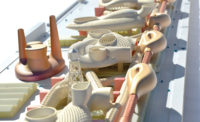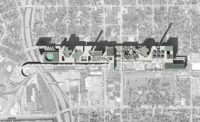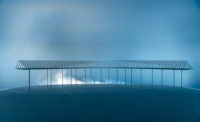For all the dreamy beauty of Venice and the grace of the stately Giardini, with its centenarian laurel and plane trees, the Architecture Biennale is often the scene of fierce, if polite, architectural battles, including career assassinations, hostile intellectual take-overs, and ritual Oedipal stabbings. Since its founding in 1980, curators take positions, their agendas displacing the status quo.
In this year’s Biennale, “Freespace,” the curators, Yvonne Farrell and Shelley McNamara, founders of the Dublin firm Grafton Architects, pursued “the generosity of spirit and sense of humanity at the core of architecture’s agenda.” But under the kinder, gentler, humanist umbrella of this seemingly benign mission statement, they basically staged an architectural Brexit, a Biennale that rejected the globalization practiced today by computer-driven starchitects in favor of localization practiced by architects with smaller operations rooted in communities, not served by jets.
Their manifesto critiqued the rampant architectural commercialism that impoverishes our environment—no argument there—but the unstated, confrontational subtext was to claim leadership for the more humble, underacknowledged architects who design buildings you simply want to touch: eye over mind, matter over concept. Interdisciplinarity, theory, and the computer itself were out as the curators focused on architecture’s own language, on the thing itself: light, space, matter, and consequent feeling.
The heroes who survive Farrell and McNamara’s decapitation are, for the most part, not marquee names but architects who have toiled nobly in the trenches doing thoughtful, community-oriented projects largely built by local craftsmen using local materials. Many hailed from developing countries; roughly half were women. In a reversal of the Biennale’s historic pattern of international capitals’ dominating provincial cities, Dublin trumped London. The Irish curators were translating into the show the “generosity” that they said is the basis of all good architecture by singing about the unsung.
In their curatorial precincts in the Biennale—the ancient Arsenale and the modern Central Pavilion in the Giardini—Farrell and McNamara explain their apparently polite but fundamentally radical coup d’état, project by project, in labels written in accessible language tailored to accessible buildings. London architect Alison Brooks believes “beauty is a language that has been lost.” Norwegian architects Jensen & Skodvin show “a deep respect for the environment,” and Irish architects de Blacam and Meagher believe “that architecture is for human beings.” The curators cite Laurent Beaudouin, who describes architecture “as a machine for slowing time down.”
To the extent that there are well-established figures, Farrell and McNamara selected formally quiet architects, like Mario Botta, chosen for his respect for “place, context, culture,” and Alvaro Siza, for his “personal poetic response.” If you squint mentally at the text labels, despite the cloying, touchy-feely platitudes, you understand that the architects are constructing an architectural vision around basics, and you appreciate there’s a certain bravery in earnestly promoting architectural “virtue” in fast-paced times focused on profits rather than sincerity.
The problem with the fundamentalism is that the curators were preaching to the converted: their values were self-evident. The error is one of omission. The show overlooks the extraordinary capacity of the computer to free space, and, in its emphasis on the village as a metaphor, it overlooks the fact that one of the most urgent issues confronting the field today is mass global urbanization. By 2050, 66 percent of humanity will be living in cities. Strangely, there were only two high-rise projects in the Arsenale’s vast exhibition area, one by Barcelona’s Carme Pinós and the other by New York’s Diller Scofidio + Renfro, which both showed that large-scale buildings could incorporate “Freespace” values. In one of the only computer-generated projects, Vietnamese architect Vo Trong Nghia (VTN) used bamboo to structure an ambitious outdoor waterside shade pavilion, Bamboo Stalactite, in an exemplary fusion of digital technology and a common material that otherwise somehow eluded the show.
There were, of course, many projects to admire, especially because—per the manifesto— most architects did not parachute into a commission with a culturally insensitive, precooked approach. Tiantian Xu, a Chinese architect and Harvard grad who heads a six person Beijing firm, DnA Design and Architecture, showed models and images of a series of small public buildings—a teahouse, theater, pedestrian bridge, museum—beautifully crafted in stone, bamboo, and wood in Chinese villages; her designs clearly grew from within the culture. British architects Peter Salter and Fenella Collingridges highlighted the issue of craft, proposing a clever, beautifully built contraption of movable seats and screens that introduced the idea of participatory architecture.
There were many engaging, touching, mostly small-scale projects exhibited in skillfully executed, often delightful installations in the Arsenale, but the Biennale lost traction in the adjacent Central Pavilion, where too many exhibits took a fallback position in intellectually safe historical territory. In a rebuttal to the computer, a large hall displayed magisterial drawings of the past, done by architects who drew like angels. The Chinese architect and Pritzker laureate Wang Shu piously noted, “Pencils, not computers, are guardians of place and atmosphere.” Other rooms exhibited four projects for Venice by the Modernist masters Le Corbusier, Louis Kahn, Frank Lloyd Wright, and Isamu Noguchi that were never built. In the central entry hall of the pavilion, a score of Irish architects interpreted in their own installations buildings that have inspired them—the Beinecke Rare Book & Manuscript Library at Yale or a theater by Auguste Perret, for example.
But the most deflating room was the prominent exhibition of Peter Zumthor. The Swiss architect displayed a towering, thumb-printed clay model; another was made in beeswax; an imposing black model, built with what looked like rocks, represented a hillside spotted with small pavilions. Zumthor rejected any digital representations, including CNC milling and digital printing. Handmade, tactile, experiential, the models represented the haptic architecture that presumably results when the values expressed in the manifesto are embodied in a building. But what the tactility of the models couldn’t hide was that Zumthor’s designs showed only an exploration of surface, not space. The buildings themselves were either boxes or pancakes.
Instead of proving the manifesto, Zumthor’s projects, occupying a commanding space as though it were an emblem of the show, cast doubt that its thesis, at least as interpreted by Zumthor, was sufficient to power a vision for a complete architecture.
The Biennale suddenly became less doctrinaire and more alive in the national pavilions on the grounds of the Giardini, outside the curatorial purview of Farrell and McNamara, where the theme “Freespace” was not interpreted so literally. The Egyptian pavilion exhibited the informal, spontaneous habitats of street vendors that in Cairo combust spontaneously within the armature of the structured city. In this ephemeral micro-economy, nothing is discarded but is reapplied and repurposed. The exuberant Spanish pavilion wallpapered all surfaces, including ceilings, with the graphic results of an open call on an open digital platform. The introductory statement of purpose captured a spirit that escaped the main show: “to expand the limits and conditions previously understood by our discipline . . . by means of a critical approach put into practice . . . in an open intellectual experience where students cook up their conflicts.” The Biennale in the Arsenale and Central Pavilion showed us what we already knew, while the less conservative Spanish pavilion searched for what we didn’t.
Each year, many countries and entities exhibit off campus, and, in its first appearance in a Venice architecture biennale, the Vatican nearly stole the show, building chapels in the park behind Palladio’s San Giorgio Maggiore, on the island opposite the Giardini. Here, in the context of a 16th-century Renaissance basilica that for centuries defined how congregations should worship, 10 firms built 10 different ecumenical ways to be Catholic: light as revelation, nature as revelation, monoliths, openness, enclosure. British starchitect Norman Foster built a particularly evocative open-air chapel structured in wood, with steel members that cross overhead to represent the crucifixion while supporting the meandering trellised structure. A liberal rather than conservative church was exploring new ground, finding new values on which to build a very old idea.
Coverage of the 2018 Venice Architecture Biennale sponsored by Hunter Douglas Architectural.







Post a comment to this article
Report Abusive Comment